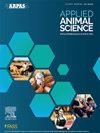Extended effects of postweaning management in southeastern beef calves
IF 1.5
Q3 AGRICULTURE, DAIRY & ANIMAL SCIENCE
引用次数: 0
Abstract
Objective
Understanding the effects of postweaning management strategy on calf performance and health can help producers add value to their operations and further strengthen the viability of the beef supply chain. Our objective with this study was to evaluate the effects of weaning and postweaning management practices and potential carryover effects on calf immune system viability and performance through the feedyard finishing phase.
Materials and Methods
A 2-yr study was conducted using 429 steer calves from 3 Auburn University research farms. Calves were randomly assigned based on weaning weights to 1 of 3 different weaning method groups: fence-line weaning, nose-flap weaning, or abrupt weaning. After the weaning period (14 d), calves were brought to a centralized farm and began a 60-d backgrounding period where they were randomized according to previous weaning management, farm of origin, and BW to 1 of 3 nutritional management strategies in a 3 × 3 split-plot design: cool-season baleage and 1% BW dried distillers grain (DDGS), bermudagrass hay and 1% BW DDGS, or grazing of mixed warm-season annuals and 1% BW DDGS. Body weights were collected throughout the trial to measure growth and performance. Blood samples were collected throughout the backgrounding period to measure vaccination response. Following backgrounding calves were transported to a commercial feedyard and followed until finishing.
Results and Discussion
Fence-line-weaned calves had the greatest ADG (P = 0.02) in the first 30 d of the backgrounding period regardless of backgrounding diet type. Calves fed the bermudagrass-hay-based diet also had a greater ADG (P < 0.0001) than both the grazing and baleage diet groups in the first 30 d of backgrounding. Steers on both the warm-season annual grazing and cool- season baleage diets supported greater ADG (P = 0.0041) during the last 30 d of the backgrounding period.
Implications and Applications
Results indicate that weaning and backgrounding management strategies may influence calf performance during the transition period into the postweaning phase and performance in the feedyard phase.
东南地区肉牛断奶后管理的延伸效应
目的了解断奶后管理策略对犊牛生产性能和健康的影响,有助于生产者为其经营增加价值,并进一步加强牛肉供应链的生存能力。本研究的目的是评估断奶和断奶后管理措施对犊牛免疫系统活力和育肥期生产性能的影响,以及潜在的后续影响。材料与方法对来自奥本大学3个研究农场的429头犊牛进行了为期2年的研究。根据断奶体重,将犊牛随机分配到围栏线断奶、鼻瓣断奶或突然断奶3个不同断奶方法组中的1个。断奶后(14 d),犊牛被带到一个集中式养殖场,开始60 d的背景期,在此期间,犊牛根据先前的断奶管理、原产农场和体重,随机选择3种营养管理策略中的1种,采用3 × 3分块设计:冷季饲草和1%体重的干酒糟(DDGS)、百米草干草和1%体重的干酒糟(DDGS),或混合放牧暖季一年生动物和1%体重的DDGS。在整个试验过程中收集体重以测量生长和性能。在整个背景期间收集血液样本以测量疫苗接种反应。随后,犊牛被运送到一个商业饲料场,并被跟踪直到肥育。结果与讨论无论背景日粮类型如何,围栏断奶犊牛在饲喂期前30 d的平均日增重最高(P = 0.02)。饲喂以百慕大草为基础的饲料的犊牛也有更高的平均日增重(P <;0.0001),高于放牧组和平衡饲粮组。在背景期的最后30 d,暖季和冷季混合饲粮的平均日增重均显著增加(P = 0.0041)。结果表明,断奶和背景管理策略可能会影响犊牛在断奶后过渡时期和饲草期的生产性能。
本文章由计算机程序翻译,如有差异,请以英文原文为准。
求助全文
约1分钟内获得全文
求助全文

 求助内容:
求助内容: 应助结果提醒方式:
应助结果提醒方式:


